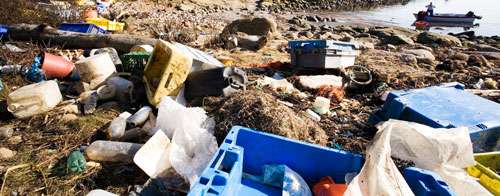Researchers study microplastic pollution effect on ocean ecology

Large amounts of plastic are found in the oceans. What are the impacts of miniature plastic particles on fish and crustaceans? And will these have ramifications for the availability of safe seafood?
Altogether, 288 million tonnes of plastic were produced worldwide in 2012. According to calculations, 28 million tonnes or 10 per cent of this ended up in the ocean. At present, little is known about the amount of plastic found in the waters along the Norwegian coast.
Plastic in everything
Nearly everything contains plastics, which can enter the waters when plastic products are left behind at the beach or waste is dumped illegally. In addition, plastics from sewage treatment plants, shipping, and oil and gas production often end up in the ocean.
Plastic in the form of very small particles, known as nanoparticles and microparticles, is polluting the marine environment. Primary microplastics are plastics fabricated for use in items such as personal care products, whereas secondary microplastics are formed as larger pieces of plastic break down in nature.
Norway's coastal areas
"We do not know much about the impact of plastic particles on ocean life or about any effects they may have on marine organisms and the marine ecosystem. A few findings exist but, as far as we know, nothing from the Norwegian coast," explains doctoral fellow and research assistant Inger Lise Nerland of the Norwegian Institute for Water Research (NIVA). At the recent doctoral and research seminar for the Research Programme on the Oceans and Coastal Areas (HAVKYST), Ms Nerland presented a research project that will further investigate these issues.
The project will provide answers to the question of how microplastic and nanoplastic particles in the marine environment affect marine organisms. The researchers will focus on a number of organisms at various trophic levels and study animal plankton, crustaceans and fish in order to find out how microplastics are ingested and the impacts of this.
The initial samples were taken from the Oslo fjord, and researchers are currently studying cod from several locations along the Norwegian coast to search for traces of microplastics in their stomachs. Marine organisms will also be exposed to microplastic particles of various types, sizes and compositions in a laboratory environment to register the effects on growth, among other things.
A threat to safe seafood?
Plastics are composed of chemical compounds. Thus far, very little is known about the interaction between plastics and environmentally hazardous substances in marine settings and how plastics may affect the toxicity of these substances. What is clear, however, is that both additives in plastics and other environmentally hazardous substances can be ingested by animals by way of plastic particles.
The scientists are especially interested in exploring whether microplastics rise up the food chain in this manner. These findings will provide the grounds for determining whether the interactions between plastics and sea animals pose a previously unknown risk to seafood as a safe source of nutrition.
Earlier international studies have identified microplastics in fish in the English Channel and the Pacific Ocean. In laboratory studies, scientists have also proven the presence of microplastics in other marine organisms and ascertained negative impacts. For example, research on blue mussels has shown that microplastics enter their circulatory system and can remain there for over 48 hours, causing a severe immunological response in the molluscs.
Provided by The Research Council of Norway



















